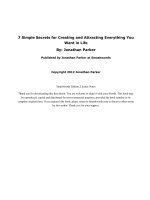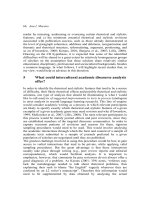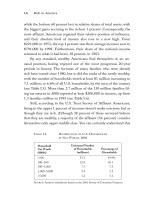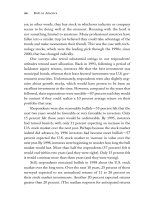Rich in America Secrets to Creating and Preserving Wealth PHẦN 4 doc
Bạn đang xem bản rút gọn của tài liệu. Xem và tải ngay bản đầy đủ của tài liệu tại đây (202.32 KB, 27 trang )
making a good salary but he had yet to put any money away. Still, as
a first-rate lawyer with a good firm, he was fairly confident of how his
career would progress and how much money he would make. Walter
knew himself as well as any client we’ve ever had; he knew how hard
he wanted to work, how much money he would need to be happy, even
how much money he wanted to give to charity. Fifteen years later,
Walter is pretty much where he thought he would be.
Another client, Henry, came to U.S. Trust in 1998. Like Walter,
he was confident that he could lay out his financial future. He had
made a great deal of money as a venture capitalist and at age 40, was
preparing to figure out what to do with his money and his future. But
even as we were laying the financial groundwork with him, Henry’s
net worth decreased precipitously. We warned him that his assets were
overly tied to one industry (technology), but he was convinced that he
knew better than anyone the strength of the two companies in which
he was heavily invested. Perhaps he did understand their technological
workings, but he failed to see how the market would react during an
industry-wide slump. Not long afterward, Henry’s wife divorced him
and gained custody of their two children. Within a relatively short
time he changed from being the head of a wealthy family to a single
man paying a great deal of alimony and retaining little income—and
holding a fraction of the assets he had once held.
These stories demonstrate that before you can become a good
investor, you must be able to answer a plethora of questions and then
create an appropriate investment plan. What are your objectives? For
example, how long do you want to work? Do you want to stay in the
same career all your life? Where do you want to live? Do you want a
second home? Do you want to marry, to have children? Remember, if
your career path changes, you will need to alter your plans accordingly.
Plans are organic. Few people are like Walter, although few people
are like Henry, either—most of us lead lives that take a middle course.
Still, we all have to change our plans as our lives take unexpected
Investments 67
02 Chapter Maurer 6/20/03 4:57 PM Page 67
turns. But it’s not necessary to abandon your entire plan in the process.
You’ll simply need to modify it to match your life’s new circumstances.
When it comes to planning, your age matters. If you’re 60 and
have sold your lifelong business, your goals will be very different from
a person of 40. At 60, you may well want to preserve and protect your
assets, while at 40, you may want to plow all that money back into
another entrepreneurial activity. (If you did, we might counsel you to
think it over. It’s great that you’ve been so successful, but not everyone
can repeat their success, and you probably don’t want to risk every-
thing. It is, of course, always your decision. But a good investment
advisor helps you to see clearly what you truly want.)
Understand the lifestyle that makes you comfortable, and then
structure your finances around your needs and desires. If what’s most
important to you is to live in a nice neighborhood, drive a nice car, and
spend a month on vacation each year, how much money does that
require? Don’t kid yourself. Some people truly love the luxuries of life.
There’s no need to pretend you don’t. You’d just be lying to yourself,
and your investment advisor, if you said that you want to give a tenth
of your money to charity when what you really want to do is take that
money and buy clothes. The odds are that’s what you’re going to do
anyway, so you need to plan on it.
Do you know your own risk tolerance? If you can’t sleep because
half of your money is sitting in the stock market, even if that’s the
most appropriate vehicle for it, investing in equities still might not be
the best thing for you. For many people, knowing that their money is
subject to the variable nature of the markets makes them too nervous
to be good investors. We had many clients who started sweating when
the markets went south in 2000. Some called us and asked if they
should sell. We explained our long-term theory of investment. Some
of them still wanted to sell everything, and we accommodated those
wishes. It now seems that selling all your stocks might have been a
very good decision, because the markets are down 40 percent from
68 Rich in America
02 Chapter Maurer 6/20/03 4:57 PM Page 68
their highs. But clients who sold and realized capital gains had to pay
a tax of 20+ percent and since it’s hard to know when the markets will
rise again and much of the forward momentum comes at the begin-
ning of those upward swings, those clients may well be giving up
potential gains. They may sleep better, but over the long term they will
miss the rewards of investing in equities.
If you know you’re not going to be able to stand the downswings
of certain investments, you should be prepared to forego the wild up-
swings as well. There’s nothing wrong with a conservative portfolio if
it’s what makes sense for you, both economically and psychologically.
And you know what to expect from it, based on your investment plan.
U.S. Trust once had another client who received a $10 million
divorce settlement in the late 1980s. She was very risk averse, and she
put most of her money in bonds. Every time her stocks rose to repre-
sent more than a quarter of the value of her portfolio, she requested that
we rebalance it by selling the remainder, and buying still more bonds.
This required a great deal of work, because in the 1990s stocks kept
rising and rising, and that meant we had to keep selling and selling. But
even when faced with the possible earnings she could have enjoyed
had she been more invested in stocks, she was happy. As she pointed
out, she never had a year in which she lost money. That was all she
needed to be content as an investor because, as she also pointed out,
she already had more money than she needed—this was a relatively
frugal woman who lived on $100,000 a year.
Be Willing to Let Go
Often, people who have created their own wealth have accomplished
it through concentration. They owned a business, they drilled an oil
well, or they held valuable stock options in their company. Their
money has been based in one place, and they tend to have a large
degree of control over it (that is, as much as anyone can).
Investments 69
02 Chapter Maurer 6/20/03 4:57 PM Page 69
One of the challenges for people who are business sellers, or those
who have cashed out of valuable stock options, is listening to others
tell them they should diversify. “Why should I?” they ask. “My wealth
has been built up because I concentrated everything on one bet. It
worked. Why change?” These people can feel very vulnerable when
they surrender their assets to an advisor, who then surrenders the
money to a number of different markets.They feel as though they have
lost control. They can no longer make changes every minute, and they
no longer have the power to control the direction of their assets.
One U.S. Trust client, Larry, started a business and ran it success-
fully for 30 years. Larry was a remarkably intelligent and resolute man,
and he was used to telling people what to do. He came to us after he
sold his business; he suddenly possessed a great deal of money, but no
particular desire to spend the rest of his life managing it. He wanted
to travel and sail, which was his new hobby.
Larry seemed to feel comfortable with us and he liked our invest-
ment philosophy. But the moment we began managing his money, we
started getting phone calls. “What’s my account doing today?” he would
ask. “Is there anything I can do about it?” Any time the markets were
down, Larry would call to fret that perhaps we should move his asset
allocation toward bonds. When the markets went up, he worried that
we weren’t heavily enough into stocks. In his portfolio were 25 stocks,
and if 24 went up, he wanted to know why we had ever invested in the
twenty-fifth, and what we were going to do about it. Eventually, Larry
did relax a little; he realized that if he was going to enjoy his retire-
ment, spending it talking to us all day wasn’t the key. But it took a while.
Letting go of control can take a while. But when you chose a good
advisor, try to trust that advisor. Give that person time. You can’t con-
trol the markets. You may not be able to control your emotions. But
you can do well by letting go and diversifying out of the one thing you
used to control.
70 Rich in America
02 Chapter Maurer 6/20/03 4:57 PM Page 70
U.S. Trust had another client, Vanessa, whose portfolio was heavily
weighted toward stocks, and within that asset class, her holdings were
mainly in General Electric (GE). Her grandfather had given her 15,000
shares of GE many years earlier and told her to hang on to it forever.
When we started working with her, Vanessa refused to rebalance her
portfolio. She felt that holding on to GE was the only right thing to do.
Finally, after years of trying, we were able to convince her to let go
enough to trust us and allow us to diversify her position. Luckily, we
instituted this change in 1999, and when GE, like many other excellent
stocks, soon lost more than half of its value, Vanessa thought we were
geniuses. We weren’t—we were simply holding true to the age old phi-
losophy of diversification. We have had many similar experiences with
clients over the years. Selling your favorite stock or your grandfather’s
favorite stock is difficult, but sometimes you have to do it.
Not everyone lets go so easily. We had yet another client who, in
the early 1990s, decided that the world was going to hell, and that
he would invest only in Treasury bills. We tried to make him change
his mind, but he wouldn’t. What we were able to do was get him to
take the income from the treasuries and invest that, since to him it
was free money. And because the bills were such a large part of his
portfolio and we were buying stocks at early 1990s prices, eventually
equities did become a large part of his portfolio—much larger than
he had intended. So we arrived at our objective of diversifying in a
manner that the client could live with. This is an example of “men-
tal accounting,” artificially segregating money into separate accounts
purely for personal and psychological reasons.
Think Contrarian
Often the market coalesces around one particular investing idea, and
you find that nearly everyone seems to be giving the same advice,
Investments 71
02 Chapter Maurer 6/20/03 4:57 PM Page 71
touting the same stocks, or predicting the same future. The consensus
isn’t always wrong, but its very existence is a warning sign when the
consensus gels into dogma. There’s a reason why this consensus has
occurred, usually because the arguments for it are so convincing. But
too often, it’s exactly such arguments that turn out to be wrong.
For example, in 1980, almost everyone predicted that the price of
oil was going to rise to $100 a barrel. Books were written about the
upcoming increase, analysts were in near accord, and stock brokers
were all in agreement. It made sense—the world was running out of
oil, and the price at the time, which was about $30 to $40 a barrel,
seemed low. This was highly logical, fact-based conjecture. It simply
turned out to be wrong. Oil didn’t go to $100 a barrel—in fact, the
price dropped below $30.
The problem with consensus is that it doesn’t tend to gel until
nearly everyone agrees with it. So in this case, everything was already
priced under the assumption that the price increase would happen.
When that phenomenon occurs, it’s usually far too late to make a
profit. Even if the price of oil had gone up $100, you still would have
gotten only a paltry return on your investment because the oil stocks
were already priced to assume this result. But if the price didn’t go to
$100, you stood to lose a lot of money—which is what happened
to most people who jumped into oil stocks at the time. Indeed, oil
stocks became too popular; their prices rose for a short time, and these
stocks came to represent 35 percent of the S&P (Standard and Poor’s)
500. Within five years, they were 5 percent.
It’s said that history repeats itself. As we all know, the consensus in
the late 1990s was that technology stocks could do no wrong. Every-
one asked, “Why not invest in the future?” And so everyone did. And
at the top of this boom, technology also rose to become 35 percent of
the S&P 500. However, once the consensus had been achieved, every-
one who was going to invest in these stocks already had, and the stocks
72 Rich in America
02 Chapter Maurer 6/20/03 4:57 PM Page 72
couldn’t go any higher. In fact, they dropped much lower. Today these
stocks represent just 15 percent of the S&P 500. It’s not that the con-
sensus is always wrong. It’s just that assets are already priced to accom-
modate it, so you have to be careful.
We have done very well by looking for financial vehicles that
other people haven’t liked, and picking them at a time when they
were depressed. Like everything else we tell you, this isn’t set in
stone. For example, if you had bought Cisco stock in the early 1990s
for $5 a share, and it rose to $100, becoming one of the world’s most
popular stocks, it wouldn’t have been necessary to sell all of your
shares. But peeling back on your holdings would have been an excel-
lent idea. One of our better-selling disciplines at U.S. Trust is that
when our successful investing idea results in one stock becoming a
large part of someone’s portfolio, we sell some. And in its place, we
don’t buy another stock like Cisco, but something different. This is
where diversification kicks in again. The more diversified your port-
folio, the less likely it is that you’ll have to worry about the effects of
consensus.
Which brings us to a related issue: Don’t fall in love with a stock.
There are times when you must sell a stock, even when you can’t artic-
ulate a reason. Without meaning to pick on Cisco, we’ll use it again
because it’s an excellent example to make the point. It is a good com-
pany, and in the late 1990s every single analyst seemed to agree on this
fact, such that its excellence was already embedded in its price. If you
had bought stock in it based on comments praising Cisco when it
was selling at $85 a share, you would have seen it rise somewhat, but
because everyone was already in agreement about that stock, you ulti-
mately stood to lose more money than you’d win.
Even with Cisco, things could have turned out differently; per-
haps their engineers could have come up with another ground break-
ing application, and the bubble would have continued. But if you had
Investments 73
02 Chapter Maurer 6/20/03 4:57 PM Page 73
bought Cisco at $100 and it went on to grow earnings by 30 percent
the following year, you would have made perhaps 10 to 20 percent, but
you also might have lost 80 percent.
Be Patient
For centuries sages have taught that patience is a virtue. It’s no differ-
ent with investing. Many people, when they first invest in a stock,
expect the stock to rise immediately. If it doesn’t, they doubt their
investment. But the true value of a company isn’t always accurately
reflected in its marketplace each day. The market is just that, a market,
composed of a multitude of varying interests: people selling stocks
because they need to raise cash, people buying stocks because they
think the stock is worth more, other people selling stock because
they think it is worth less, and/or people who are buying or selling
because they think the economy in general is going down.
For example, today Microsoft’s stock is selling at half the price it
garnered two years ago. Does that mean it’s worth half as much?
Maybe, or maybe not. We only can try to predict what a company’s
earning growth may be and what valuation the market will put on that
growth rate at any point in time. Where will interest rates be? Will
there be inflation? There’s no way to know. But with financial invest-
ments, people become impatient to know their precise worth at every
moment. Do you reprice your home every day, or your artwork, or your
jewelry? No, although in today’s world it is tempting. But stocks are
repriced constantly. That price can be influenced by a series of factors,
not always reflecting the true value of the company or the franchise.
So be patient. If you believe Microsoft is a great company, don’t
sell it because it’s dipped. Maybe the market doesn’t agree with you
right now, but maybe it does and there are other factors that are keep-
ing Microsoft down, such as a general displeasure with technology
stocks in general, or a fear that the economy is doing poorly.
74 Rich in America
02 Chapter Maurer 6/20/03 4:57 PM Page 74
As previously mentioned, some people believe in something called
market timing, which nearly everyone seems convinced at one point
or another that they can master (see Figure 2.5). Nearly everyone is
wrong. It’s tempting to think that you can predict when the market
is going to go up or down. It’s tempting to want to buy something the
moment you hear good news about it, or sell something because you
hear bad news. But no one really knows exactly when the markets are
going to rise and fall. Yes, there were many people who predicted the
market was going to go down in 2000, and they sold their stocks. But
does that mean they know when to get back in?
Over the past century, the markets have often rebounded substan-
tially before people began reinvesting their money. In October 1987
the market crashed 35 percent; many people claimed that they had
sold everything just before. But how many of them also knew that
within 18 months the market would have rebounded to higher levels?
Every day of the week you can read expert predictions about the stock
Investments 75
13.6%
7.7%
3.4%
−3.0%
−5.7%
0%
entire
period
minus
10
best
days
minus
20
best
days
minus
30
best
days
minus
40
best
days
minus
50
best
days
(Annualized rates of return
S&P 500 Index: 1.1.94 through 12.31.01)
FIGURE 2.5 HAZARDS OF MARKET TIMING
02 Chapter Maurer 6/20/03 4:57 PM Page 75
market. Some of these people predict the market will be going up,
others promise it will be flat, and still others swear it will be down.
Timing the market is a difficult, nearly impossible task.
76 Rich in America
Investing and Taxes
The relationship between investing and taxes is often overlooked
by investors when planning their investment strategy (see Figure
2.6). It isn’t just the rate of return that’s important, but the rate of
return after taxes—what you get to keep. (For more detailed infor-
mation on this subject, see Chapter 3.)
Studies from the Securities and Exchange Commission, the
government organization that monitors the markets, show that
taxes can take 5.6 percent off the annual return of the least tax
efficiently managed portfolios. On average, taxes reduce equity
returns by about 2.5 percent a year. In 2000, investors paid more
than $100 billion in capital gains taxes alone. Now 2.5 percent per
year doesn’t seem like much, but on an initial portfolio of $5 mil-
lion, 2.5 percent over 10 years equals almost $1.5 million. The
recently enacted tax act will modestly reduce the cost of taxes.
Any good investment advisor will also be a tax-intelligent
investor. That doesn’t mean that tax decisions drive investment
decisions. Investment decisions should be made in light of invest-
ment objectives. But for most people, their main objective is to
achieve the maximum return possible relative to the degree of risk
on an after-tax basis. This means that you should know what the
IRS permits and what it doesn’t permit in terms of investments.
You should be aware of when it is best to sell your holdings and the
tax implications of doing so. Investing in various sectors through
a number of “best in class” managers almost always means that
you will be trading off tax management for hopefully superior per-
formance even after taxes.
02 Chapter Maurer 6/20/03 4:57 PM Page 76
Investment Advisors
How Many Do You Need?
One relatively new question that intelligent investors must consider:
How many advisors are right for you? For most of the last century,
people usually worked with one investment advisor, who constructed
a portfolio that was designed specifically for them. But as investing
has grown more complicated, places like U.S. Trust have introduced
a system whereby specialized experts manage different segments of a
given portfolio to provide even more diversification and specializa-
tion. After all, can one investment firm be competent across all of
the investment sectors required of a well-diversified investment port-
folio? The answer is probably no.Therefore, a new approach called open
architecture has emerged.
Investments 77
Stocks
Bonds
Treasury Bills
10.7% 5.3% 3.8%
7.5% 3.7% 2.5% 4.4% 0.6% −0.6%
TOTAL RETURN AFTER-TAX RETURN
RETURN AFTER TAXES
AND INFLATION
Assumptions:
Income Tax Rate: 39%
Capital Gains Tax Rate: 20%
Fees and Transaction Costs: 0.90%
Gains realized every 5 years
CPI Actual: 3.1% year
Source: Calculated by U.S.
Trust using data presented
in Stocks, Bonds, Bills and
Inflation
®
2001 Yearbook,
©2001 Ibbotson Associates,
Inc. Based on copyrighted
works by Ibbotson and
Sinquefield. All rights
reserved. Used with
permission.
ANNUALIZED TOTAL RETURN AND THE EFFECT OF TAXES AND INFLATION
(1926–2001)
FIGURE 2.6 THE SUPERIOR PERFORMANCE OF EQUITIES
02 Chapter Maurer 6/20/03 4:57 PM Page 77
Open architecture allows an investor to enjoy the efficiency of
dealing with one firm while enjoying the benefit of working with spe-
cialty managers. In this system, investors do not develop a relationship
with all of the portfolio managers, but instead are serviced by a rela-
tionship manager whose skill set is investment planning; he or she
develops an appropriate asset allocation for the client and then selects
proprietary or nonproprietary products to fill the client’s portfolio.
Open architecture also allows clients to achieve greater diversification
by having a choice of many more vehicles than they might ordinarily
have. Over time, the relationship manager will rebalance the portfolio
to keep the asset allocation in line with the financial plan, and will also
review the performance of each sector to monitor the performance of
the individual sector managers.
Based on the quantity of assets being invested, sector management
can be accomplished via mutual funds or separately managed accounts.
Clients receive similar performance with either vehicle, so the decision
of which will be used is generally driven by expenses, along with certain
tax considerations. Additional costs are usually associated with this new
approach of sector management versus the traditional approach. Fees
are generally higher because each segment manager charges an individ-
ual set of fees that don’t take into account the size of an entire relation-
ship. In addition, sector management can also be less tax-efficient, as
the various managers may not communicate with each other vis-à-vis
your tax needs, whereas with customized management, your portfolio
manager will know your gain and loss situation well. Many new firms
do not offer classic portfolio management services, but provide invest-
ment planning and help you select managers to meet your needs.These
firms charge based on the assets they supervise.
Balance
Overall, the key to a good investment program is balance. A stock,
a bond, a hedge fund, or real estate—each has unique investment
78 Rich in America
02 Chapter Maurer 6/20/03 4:57 PM Page 78
characteristics. Each has seen a different rate of return over long peri-
ods of time, and each has a different impact on your overall portfolio
if it goes up or down. It would be nice if we could predict exactly
which of these vehicles are going to perform the best over the next
decade and then simply place all of our money into it, make a fortune,
and then shift the money elsewhere when we know another vehicle is
going to rise.
Unfortunately, no one can do that. Still, over a long period of time,
we think good advisors can achieve an excellent balance of all the pos-
sible investment vehicles. If your advisor can give you a good long-
term return above the rate of inflation and can reduce the discomfort
you experience on an interim basis, he or she has done you a great
service. Although there will always be something working for you and
something working against you in your portfolio, on average you will
have smooth returns rather than big up-and-down spikes in the value
of your portfolio and in the lining of your stomach.
Thus, you should beware of advisors who say they were number 1
on some list last year. The odds are excellent they will not be number
1 again this year, and you missed their great year. Frankly, we feel
that anyone who can be above average year after year is an excellent
advisor. Certainly, when you were in school no one urged you to
be slightly above average, but think about it: If each year your advisor
is able to beat the S&P 500 Index, that means that over the long
term, you have found yourself an excellent advisor, because he or
she has been able to do something that few people can—give you a
steady return on your investment. Huge bets won’t get you there. Bal-
ance will.
Active versus Passive Managers
When seeking an advisor, you probably will hear about both active and
passive managers. If they are doing their job well, active managers apply
Investments 79
02 Chapter Maurer 6/20/03 4:57 PM Page 79
disciplined analysis to find value in individual companies, sectors, or
markets that other investors haven’t spotted yet. Their goal is to outper-
form the market through solid strategies, research, and analysis. Active
managers continually monitor the performance of the companies whose
shares they own and even communicate with their management.
Unfortunately, statistics reveal that most active managers do no
better than the performance of standard market indexes such as the
S&P 500. When you take into account the fees paid to active man-
agers, the disparity between their performance and the index grows
more obvious. As a result, a new segment of the investment manage-
ment industry became popular: managers who invest passively. Passive
managers view stocks as commodities. Their goal is to replicate the
performance of the market, and they purchase “market baskets” of
stocks selected to reflect the composition of the market, such as those
in the S&P 500 Index. Passive managers argue that it is impossible
to outperform the market, so one might as well just own the market.
Active managers generally charge fees relative to the size of the account;
they may range from 0.5 to 1.5 percent. Passive managers generally
charge fees of between 0.1 and 0.25 percent.
Certain risks are unique to passive investing. During the TMT
bubble, investors in passively managed S&P funds suffered when
those funds increased their holdings in TMT to 45 percent to match
the indexes’ exposure, and the index suffered when that bubble burst.
Some individual managers invested in large-cap funds actually did much
better than the S&P. Passive management is not always tax-efficient;
however, passive management techniques have been refined to ensure
more tax efficiency than in the past especially in separately managed
passive accounts.
Whether to invest with active or passive managers is a debate that
will continue. Many investors have determined that there is a place in
their portfolio for both active and passive management.
80 Rich in America
02 Chapter Maurer 6/20/03 4:57 PM Page 80
Types of Investments
and Investment Terminology
Equities
Stocks, or equities, are sold through the stock market. When you buy
common stock in a company, no matter how small your purchase, you
are essentially buying an ownership position in it; together, all the
stockholders own that company.
Return refers to how much money you make back on your invest-
ment. If you buy a stock for $10,000 and sell it for $15,000, your return
is $5,000, or 50 percent.
Price /earnings (P/E) ratio is a common formula with which to
judge a stock’s value. It stands for the relationship between the stock’s
price and the company’s earnings for the last four quarters. To deter-
mine the P/E ratio, you divide the company share price by the earn-
ings per share. If a company has a P/E of 15, it means that its price is
15 times its annual per-share earnings.
Stock splits take place when a company decides that the price of its
stock is too high, and it then splits, or divides the stock, usually in two
(if you owned 100 shares before the split, you would own 200 after);
sometimes companies decide to split the stock in thirds, or in frac-
tions. Companies can also establish a reverse split when they think
their share price is too low. In that case, if you owned 100 shares before
the split, you would own only 50.
Dividends are paid to stockholders out of the company’s profits.
Not all stocks pay dividends, which tend to be small and are given
out completely at the discretion of the company. This means that the
dividends may well grow or disappear from year to year.
Large-capitalization and small-capitalization refer to the value these
stocks possess, determined by multiplying the number of shares offered
Investments 81
02 Chapter Maurer 6/20/03 4:57 PM Page 81
by the current market price of a single share. Large-cap stocks are
those calculated at more than $3 billion of outstanding market value,
and small-cap stocks are those whose value is less than $1.5 billion.
In between, not surprisingly, are stocks known as mid-caps. Another
category is micro-caps whose value is less than $100 million.
Growth companies are those that have shown faster-than-average
gains in earnings over the past few years, which, it is hoped, will con-
tinue to grow at an above-average rate.
Value companies are those that haven’t been doing as well as others
in recent years, yet are considered to have value because they are inex-
pensive relative to their assets and are, it is hoped, ready to turn around
and improve their profitability and growth rates (see Figure 2.7)
Blue chip stocks are those that have historically done very well com-
pared to the rest of the market, are well managed, and enjoy an excel-
lent reputation.
82 Rich in America
20
15
10
5
0
−5
−10
−15
−
2
0
RESULTS FROM DIFFERENT STYLES NARROW AS HORIZON LENGTHENS
Growth
−
12.7
%
11.1
%
12.
3%
V
a
l
ue
−
11.7
%
9
.
5
%1
3
.1
%
Spread: High-Low −1.
0
% 1.
6
%
0
.
8
%
Investment Styles 1
Year
(
ended 12/31/01
)
5 Year
(
en
d
e
d
12/31/01
)
10 Year
(
ended 12/31/01
)
Dark line = Value
Light line = Growth
Return %
FIGURE 2.7 PERFORMANCE OF GROWTH AND VALUE STRATEGIES OVER
THE
LONG TERM
02 Chapter Maurer 6/20/03 4:57 PM Page 82
Preferred stock has traits of both stocks and bonds. Like bonds, pre-
ferred stocks pay dividends, and they can rise (or fall) like stocks. The
downside is that the dividend doesn’t rise even if the company’s profits
do, and the share price doesn’t move up as quickly as its common stock.
Defensive stocks are those of utilities, health care providers, food
companies, and other businesses that are considered less prone to mar-
ket slides because the demand for their products continues even dur-
ing lean times. The opposites of defensive stocks are cyclical stocks, such
as airline or mining stocks, which can do very well when times are
flush but perform poorly when the economy is shrinking.
Selling short is a strategy used when you think a certain company’s
stock price is going to fall. Essentially, you borrow the shares from
your broker, sell them, and wait for the stock to fall. If and when it
does, you then buy the stock at its new lower price, and repay your bro-
ker the original amount. For instance, say you sell 100 shares of XYZ
stock short at $50. When the price drops to $25, you buy 100 shares at
$25, give them to your broker, and keep the $25 per share difference as
profit (although you will have to pay a commission). However, if you
are wrong and the stock doubles, you would lose your money.
Buying on margin means that you borrow money from your broker
to finance a portion of the stock you are buying. If you want to buy
$10,000 worth of stock, but only want to spend $5,000, the broker will
put up the other $5,000. If the stock then goes up to $15,000 and you
sell it, you must pay back your broker the $5,000, but you have earned
a 100 percent profit. However, if the stock goes down, you, not the
broker, absorb all the losses.
Real estate investment trusts (REITs), are a way of investing in
real estate without actually buying real estate. Instead, you buy stock
in a company that owns property, and the price of your stock goes up
or down depending on the performance of the company (and there-
fore the real estate market). There are many kinds of REITs, but the
most common are equity REITs; also available are mortgage REITs,
Investments 83
02 Chapter Maurer 6/20/03 4:57 PM Page 83
which invest in real estate loans, and blind REITs, which don’t dis-
close their property holdings.
Bonds
Although most people who know a little about investing are aware of
stocks, bonds are much less understood (see Figure 2.8). Bonds, or
fixed-income securities, are an important component of any invest-
ment portfolio. With the exception of what are known as zero-coupon
bonds, bonds provide a steady income stream, preserve principal, and
add balance to your portfolio by reducing risk and volatility.
A bond is a loan to a company, state, municipality, or government.
You are repaid interest and principal. Most bonds pay a fixed dollar
amount of interest at regular intervals (usually every six months) until
maturity. At maturity, principal (face value) is repaid.
Bonds involve two major risks: interest rate risk and credit risk.
Interest rate risk is the risk that rising interest rates will lower the price
of bonds. If you buy and hold a bond with a 5 percent interest rate and
interest rates go up by 1 percent a year for two years, up to 20 percent
of the value of your bond may erode. If you hold the bond to maturity,
you will not lose any principal, but the yield you receive in the interim
will be below market rates. Most bond managers manage interest rate
risk by structuring a portfolio with bonds of “staggered” or “laddered”
maturities.
Credit risk is the risk that the issuer of your bond will not be able
to pay back your principal or pay interest. Most bond managers will
select only high-quality bonds to minimize credit risk. They will need
to have a research function to measure credit risk, because credit risk
is a real risk even in municipal bond portfolios. For example, in the
1970s, investors in New York City bonds were painfully reminded
about credit risk when their bonds were restructured. The city’s fiscal
84 Rich in America
02 Chapter Maurer 6/20/03 4:57 PM Page 84
Investments 85
0.7%
13.3%
U.S. Stocks
Foreign Stocks
Emerging Market Stocks
T-Bills
Intermed. Bonds
Inflation
2.1%
14.7%
−5.1%
29.1%
−31.8%
−23.2%
−26.5%
71.3%
69.9%
Best Yea
r
Worst Yea
r
RANGE OF ONE-YEAR RETURNS
(
196
0
–
2001
)
Throughout this text, U.S. stocks are represented by the Standard & Poor's 500-stock Index—500
of the largest stocks, as measured by market value, of the 9,000 traded in the U.S. The S&P 500
is often used as a proxy for the U.S. stock market. Foreign stocks from the developed markets are
represented by the Morgan Stanley Capital International (MSCI, EAFE, Europe, Australia, and
the Far East) Index of major overseas stock markets, with countries weighted in proportion to
their gross domestic products. Foreign stocks from the emerging markets are represented by
the International Finance Corporation of the World Bank Global Index (IFC) from 1985 to 1987
and by the MSCI Emerging Markets Free Index from 1988 to 1995. Intermediate bonds are
represented by Treasuries with an approximate maturity of five years. "Return" refers to total
return: interest and/or dividends plus or minus price change (capital appreciation or depreciation).
Source: Calculated by U.S. Trust using data presented in Stocks, Bonds, Bills and Inflation
®
2001 Yearbook, ©2001 Ibbotson Associates, Inc. Based on copyrighted works by Ibbotson and
Sinquefield. All rights reserved. Used with permission. International Finance Corp. (for emerging
markets, 1985–87), Morgan Stanley Capital International (for developed foreign markets, 1970–99
and emerging markets, 1988–99) and Standard & Poor's Corp.
The short-term risk in bonds is risin
g interest rates, which
de
p
ress bond
p
rices
—
particularly at long maturities
.
MAT
U
RIT
Y
$70
$80
$90
$
10
0
Beginning Prices
Prices After One Year
Prices After Two Years
(if interest rates rise by 1% a year for 2 years
)
Cash
(3 months)
Short Bonds
(2 years)
Intermediate Bonds
(6 years)
Long Bonds
(30 years)
* Assumes beginning yields at 5% for three-month bills, 6.5% for two-year bonds, 7% for
six-year bonds and 7.5% for 30-year bonds, with rates rising equally at all maturities.
but if you're investing for just a year, fixed-income securities
are more secure than stocks.
FIGURE 2.8 THE ROLE OF BONDS IN A PORTFOLIO
02 Chapter Maurer 6/20/03 4:57 PM Page 85
crisis prompted it to renegotiate the terms of its debt arrangements,
and bondholders were left with pennies on the dollar. Had the city
defaulted on its debt, bondholders would have ended up with nothing.
Investors in Orange County, California, bonds endured a similar situ-
ation in the 1990s.
Generally speaking, individual investors will place the majority
of their fixed-income investments in tax-free or municipal bonds.
Municipal bonds generally are exempt from federal income tax and
also from state income tax for residents of the state in which they were
issued. Because they are free from tax, the after-tax yields are quite
impressive. Almost all investment firms now offer fixed-income vehi-
cles to accommodate individual investors.
Size is very important in municipal bond investing. Unless your
portfolio warrants investing several million dollars in bonds, you will
be better off investing in bond funds, which enjoy the benefit of size
when investing in the often inefficient municipal bond market.
Most individual clients have assets invested in tax-deferred vehi-
cles such as a 401(k) plan. Fixed-income securities within those plans
are usually invested in taxable bonds, most likely government-backed
bonds or corporate bonds. Bonds backed by the federal government do
not have credit risk, only interest rate risk. Corporate bonds involve a
great deal of credit risk and also interest rate risk.
A coupon is the annual interest paid on a debt security, usually
stated in terms of the rate paid on a bond’s face value. The coupon is
set at the time a security is issued. Coupon rates usually vary with
maturity (the longer the maturity, the higher the rate) and with the
issuer’s creditworthiness at the time of issuance (the higher the qual-
ity, the lower the rate).
Total return consists of the bond’s income as well as the apprecia-
tion or depreciation of its price. Market risk reflects the potential fluc-
tuation in value a bond can experience when interest rates rise or fall
after the purchase of a fixed-income security. If rates rise, the bond’s
86 Rich in America
02 Chapter Maurer 6/20/03 4:57 PM Page 86
price will decline so that its current yield reflects the new, higher rates.
Conversely, if rates decline, the bond’s price will rise. Lower-quality
bonds generally offer higher yields than better-quality issues, but also
may be more volatile. The higher yield compensates the investor for
lending money to an issuer that is considered more likely to default,
that is, not make timely interest or principal payments.
Types of Bonds
There are literally millions of bond issues in the United States alone.
These fixed-income securities are defined by several characteristics:
• Issuer: U.S. Treasury, U.S. government agency, corporation, or
state or local government
• Maturity: From 1 day to 30 years or more
• Credit quality: From high-quality U.S. Treasury securities to
junk bonds
• Structure: Notes, debentures, or mortgage-backed or asset-
backed securities
Treasuries are debt obligations of the U.S. government secured by its
full faith and credit and issued at various schedules and maturities. The
U.S. Treasury issues three types of debt: bills (with a maturity of less
than one year), notes (2 to 10 years), and bonds (more than 10 years).
Interest from U.S. Treasuries is federally taxable but exempt from state
and local taxes.
Mortgage-backed securities are usually issued and/or guaranteed by
a U.S. government–sponsored agency. The Government National
Mortgage Association (Ginnie Mae) is backed by the full faith and
credit of the U.S. government. The Federal National Mortgage Asso-
ciation (Fannie Mae) and the Federal Home Loan Mortgage Corpo-
ration (Freddie Mac) are chartered by Congress, but are owned by
Investments 87
02 Chapter Maurer 6/20/03 4:57 PM Page 87
stockholders. These agencies buy qualified mortgage loans or guaran-
tee pools of such loans owned by financial institutions. The loans are
then securitized and distributed through financial institutions. Unlike
most bonds, mortgages usually amortize principal over all or part of
the bond’s life, instead of paying it all at maturity.
Corporate bonds represent debt issued by corporations (financial,
industrial, or service-related). Companies use the funds they raise
from selling bonds for a variety of purposes, such as building facilities
or purchasing equipment. Corporate bonds are subject to federal and
state taxes.
Municipal bonds are debt issued by states, municipalities, and other
government divisions to improve or build infrastructure, hospitals,
schools, etc.The issuance of bonds allows local governments to borrow
money to finance their capital expenditures. Municipal bonds are gen-
erally exempt from federal income taxes and income tax in the state
from which they are issued (but they may be subject to the Alternative
Minimum Tax).
Taxable bonds and tax-exempt bonds provide a steady income
stream to an investor. The interest income can be either taxable or tax-
exempt, (see Figure 2.9.) A taxable bond is a general obligation whose
interest is subject to federal and/or state and local income tax.
Examples include corporate bonds, U.S. Treasury bonds, money mar-
ket funds, and bond unit investments trusts. A tax-exempt bond is a
bond that is not subject to these taxes.
Deciding between taxable and tax-exempt bonds should take into
account the investor’s income tax bracket and the difference in the
earnings between a taxable versus a tax-exempt bond. An investor
in a high tax bracket may want to consider buying tax-exempt bonds
as a way of receiving a higher income stream, whereas an investor in a
lower tax bracket may consider a taxable bond. Another consideration
with tax-exempt bonds is that you will need to account for any capital
gains or losses if the bonds are sold prior to maturity.
88 Rich in America
02 Chapter Maurer 6/20/03 4:57 PM Page 88
Zero-coupon bonds are bonds sold at a deep discount; you don’t col-
lect interest, but instead get to buy the bond at a lower price than it
will have when it matures (or comes due).
Mutual Funds
By buying mutual funds, you can invest your money without having to
become an expert at picking individual securities. You and other
investors are, in effect, pooling your money, and the fund’s manager
then makes the actual selection of stocks, bonds, or anything else
appropriate for the portfolio. This way, $10,000 can be invested in a
fund that may own stock in up to a hundred companies or more,
instead of sitting in just one or two stocks or bonds. A multitude of
funds are available to invest in, from large-cap to small-cap, from
international to those focused on a specific sector (such as technology
or health), from gold to silver, from bond funds to index funds (which
track the performance of an index the mutual fund chooses to follow).
Investments 89
AAA Municipals vs. U.S. Treasury Obligations
0.5
1
1.5
2
2.5
3
3.5
4
4.5
5
5.5
6
1
Ye a
r
2
Ye a
r
s
3Yea
r
s
4
Ye a
r
s
5 Years 10 Years 15 Years 20 Years
A
AAA M
un
i
c
ip
a
l
s
B
U.
S
. Treasur
yO
bli
g
ations
C
U.
S
. Treasur
y
(After 28% Tax)
D
U.
S
. Treasur
y
(After 38.6% Tax)
A
B
D
C
Rate of Return
FIGURE 2.9 FIXED-INCOME COMPARATIVE YIELDS (as of May 12, 2003)
02 Chapter Maurer 6/20/03 4:57 PM Page 89
Open-end funds sell as many shares as investors want to buy. The
more money invested, the more shares exist in the fund; if investors
sell off the fund, the number of shares drops. You can buy or sell the
fund depending on the cost of the fund’s value on the day you want to
do business, just as with a stock. Closed-end funds raise money only
once, offer a fixed number of shares, and are traded on an exchange or
over the counter. The market price goes up or down depending on
investor demand, as well as changes in the value of its holdings.
Load funds charge a commission to invest in them; when you
buy a front-end load fund, you pay your commission when you buy
the fund (and there may be other charges as well). A back-end fund
means that you pay when you sell your shares in the fund. A no-load
fund is usually bought directly from the fund company itself, which
charges no commissions (although that doesn’t mean there won’t be
some other charges; management fees are charged on an ongoing basis,
so make sure to ask). A level load means that the fee is deducted reg-
ularly from the value of your shares. Loads can run anywhere from
0.75 percent all the way up to 7.5 percent or more, so you should ask
ahead of time.
Nontraditional Asset Classes
These assets include venture capital, private equity, real estate, and
(more recently) hedge funds. A properly diversified portfolio will
include representation from all of these sectors. Most of these asset
classes involve more risk and higher returns. Their performance is not
correlated to the general equity markets. Nontraditional assets should
represent a meaningful (10 to 30 percent) allocation in your portfolio
depending on your time horizon and risk parameters. As specialty
investment classes, they are usually handled by specialty managers
with whom you invest directly.
90 Rich in America
02 Chapter Maurer 6/20/03 4:57 PM Page 90
It is prudent to have more than one manager for each class, and in
certain sectors, such as hedge funds, investing with up to a dozen or
more managers may make sense. Because these managers require large
minimum investments, only the very affluent can afford to invest
directly with them. Therefore, a new kind of management vehicle has
emerged called the fund of funds. This vehicle allows investors to invest
in as many as 10 to 40 hedge funds (or venture capital funds or buyout
funds) by investing in one commingled fund. The manager of the
commingled fund is responsible for identifying the underlying man-
agers and constructing a portfolio of those managers that makes sense.
Funds of funds offer a compelling way for an individual to invest in
nontraditional asset classes.
Hedge Fund Investing
Most equity managers invest by buying shares of stock in firms they
believe represent a good value. Such managers are referred to as long-
only managers. Some managers also identify securities that they believe
are overvalued and sell shares of stock in those companies. Those man-
agers are said to short the stock.
The short-selling process has many rules, but as mentioned ear-
lier, the basic procedure is that the manager borrows the stock from a
broker and sells it. The manager will repay the stock at some point in
the future, presumably when the market has fallen and the stock can
be repurchased at a cheaper price.
This process does have risks.To compensate, the manager will often
“hedge” the short investment by buying the stock of a similar company
the manager believes is also undervalued. By buying stocks in pairs, the
manager mitigates risk, because if the entire sector to which the stock
belongs, say pharmaceuticals, does well, the two positions will offset
each another. While in the above example these stocks are in the same
Investments 91
02 Chapter Maurer 6/20/03 4:57 PM Page 91









